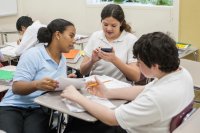Thwarting Deficit Narratives in Math Class
To counter societal messages about who is able to be successful in math, teachers can help all students recognize their math brilliance.
Messages in the world about who can and cannot be successful in math influence students’ perceptions of themselves. These messages hold some back and push others forward: Some students see themselves as full participants in mathematics, and some do not. These self-assessments can be predicted by race, class, gender, sexuality, and more, and they can reinforce the stereotypes in those initial messages, perpetuating inequitable educational outcomes.
Aditya Adiredja calls these messages “deficit master-narratives.” Our classrooms are not islands—the prejudices and biases of the world impact us. These deficit narratives send clear signals about who is and isn’t a mathematician. Ignoring them allows deficit thinking to proliferate. To undermine such thinking, I can go into each class assuming that every student is brilliant and that my job is to find ways for each student to recognize and celebrate their brilliance.
Describing ways in which we can push back against deficit narratives, Rochelle Gutiérrez uses the phrase “rehumanizing mathematics.” Math is often seen as a sterile subject of esoteric truths and arcane formality, inhuman and accessible only to a select few. Rehumanizing math means helping every student bring their full self to class and see themselves as authentic doers of mathematics rather than observers of a distant subject.
Broadening How We Think of Math
Rehumanizing math can feel like an enormous task. How can teachers get started?
One idea Gutiérrez identifies is broadening what we think of as mathematics. Many students see math as a subject about remembering the right procedure and then calculating quickly and accurately. Yet the discipline of mathematics is also about making sense of new ideas, reconciling different representations, and exploring potential contradictions. Mathematicians practice these habits of mind to move the field forward and explore new frontiers. What might broadening mathematics to value these habits look like in a high school math class?
My precalculus students are often confused about asymptotes when we study rational functions. A rational function can never intersect its vertical asymptote, but can intersect its horizontal asymptote. This potential contradiction feels frustrating and counterintuitive to students, and they often complain that these graphs don’t make sense.
I used to tie myself in knots trying to help students reason through this tension within the definition of a function, building toward ideas about limits and end behavior. I see so much beautiful mathematical learning in this moment. But in my rush to impart my knowledge and my perspective, I was missing something critical. The instinct to question and to push at seeming contradictions is an essential way of being mathematically smart.
When students say, “That doesn’t make sense,” they’re attempting to reconcile their ideas with the evidence in front of them. They’re not confused—they’re drawing on their knowledge and engaging in critical mathematical thinking. My role as a teacher is to recognize that thinking as an essential part of being mathematically smart, and to help my students see themselves as practicing mathematics in new ways, not as being confused about a hard concept.
We often tell ourselves that in math there’s always a right and wrong answer and skip past moments of ambiguity and tension, but these can be moments of productive struggle and learning, and they can also be moments when we broaden the ways that students can see themselves as mathematically smart. Mathematics as a field has advanced when mathematicians ask questions to resolve uncertainty, and we can embrace moments of ambiguity as opportunities to broaden what our students see as doing and practicing mathematics.
Being smart doesn’t always mean knowing how to solve a problem—just as often it means knowing how to ask a useful question. When teachers help students to see themselves as mathematically smart in new ways, we create new opportunities for students to recognize their brilliance and undermine messages that might tell students they aren’t able to be successful in mathematics.
Creating Mathematics
A second area Gutiérrez identifies is creating math. This doesn’t mean that students need to invent mathematical ideas in their entirety—expecting that would lead to some students feeling successful and many others becoming frustrated as it would seem to confirm their limited conceptions of themselves.
So creating math is not limited to inventing new mathematical ideas—experimenting with new ways to describe math is also creating it. Playing with rational functions, I can embrace the informal language that students naturally use to describe what they see, rather than imposing predefined mathematical language on them. Chunks, parabola-y things, swoops, and more are useful descriptors for this area of math. It only takes a moment to invent some new language, a moment that can undermine the deficit master-narratives telling students they’re not full participants in math. This can also be a moment of levity and fun that can send a new message about what it means to do mathematics.
When I first heard Gutiérrez talk about rehumanizing mathematics, I saw it as an insurmountable challenge, disrupting and reinventing mathematics from the ground up. The idea that reimagining mathematics is too difficult can paralyze us, preventing us from making changes within our sphere of influence.
Broadening what we think of as math and encouraging students to describe math on their own terms are tiny steps, but they are also two ways I’ve learned to see my teaching from a new perspective. What might mathematics education look like if every day we found new ways to surface the brilliance of every student?
